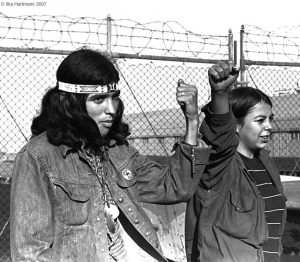For centuries, Native Americans have been possibly the most neglected, disrespected, and oppressed communities on American soil. They are often viewed as powerless or weak, and their wishes and rights are often disregarded. In 1968, a movement emerged in hopes of restoring the identity of the American Indian and the hope that had been lost for generations.
The American Indian Movement (AIM) began in Minneapolis, Minnesota as a response to police harassment in the area. A group organized an “Indian Patrol” to monitor police due to the alarmingly

high weekend arrest rate (Bigony 47). The Indian Patrol was a shocking success and managed to gave new hope to other Native American communities nationwide that they could also fight injustices in their community, which birthed the American Indian Movement.
Many were attracted to the movement for the promise of a better life through AIM’s commitment to changing the oppressive social structure that Native Americans are forced to endure. AIM hoped to achieve this goal by stressing the importance of reclaiming traditional Native beliefs. Encouraging communities to reconstruct their notions of personal and collective identity and reclaim their Indian identity creates a sense of unity and solidarity within the entire community, which increases involvement in protests and activism (Nagel 958). The growth of the AIM throughout the late 1960s also saw a surge of Indian pride and consciousness throughout the entire nation.

The biggest turning point of the AIM was marked by the Alcatraz takeover. One of the most well known Native activist moments was when Richard Oakes and Indian students from San Francisco State University claimed Alcatraz Island by what they claimed to be “right of discovery.” The occupation caught the attention of the civil rights movement that was intensifying nationwide. The takeover was monumental for both those involved and those who simply witnessed. It changed the lens with which everyone was forced to view Native Americans, which often viewed them as powerless (Nagel 958). The occupation proved that Native Americans are powerful and successfully highlighted the injustices of Native peoples while promoting ethnic pride.
Since then, AIM has successfully organized many protests and demonstrations that resulted in major milestones in the movement, such as, the Trial of Broken Treaties, the Bureau of Indian Affairs building takeover, the occupation of Wounded Knee, the Federation of Survivor Schools, and the Longest Walk. Although many of these demonstrations did not achieve their intended goals, they all powerfully promoted ethnic pride and ethnic consciousness despite the oppression faced by the government in a movement that continues to this day.
Works Cited
Bigony, Beatrice A. (1979). Attempting to Close the Sacred Circle: The Endeavor of the American Indian Movement. Central Issues in Anthropology 1(2): 41–62.
Nagel, Joane. (1995). American Indian Ethnic Renewal: Politics and the Resurgence of Identity. American Sociological Review 60(6): 947–965.
Further Reading
https://www.theatlantic.com/national/archive/2012/10/occupy-wounded-knee-a-71-day-siege-and-a-forgotten-civil-rights-movement/263998/
